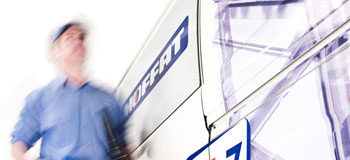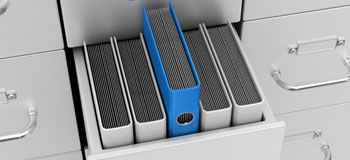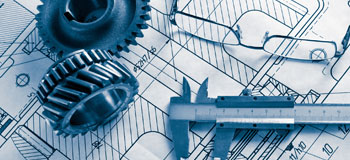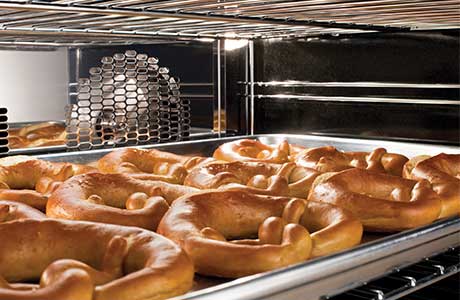
Convection Oven vs Conventional Oven
Highlights
Conventional ovens use radiant heat that emanates from the top and/or bottom surfaces to heat the oven chamber. By way of definition radiating heat is basically heating energy transmitted by electromagnetic waves in contrast to heat transmitted by conduction or convection. The result tends to produce hot and cold spots in the oven chamber which can often lead to uneven cooking results. For commercial cooking applications this method of transferring heat can limit both cooking results and menu options by way of achieving an even cooking result.
To achieve an even cooking result for larger meat products you are required to shift the meat product around the oven to accommodate to uneven pockets of temperature, which is why the allure of faster cooking times, evenly cooked food and the improved energy efficiency in convection ovens is hard to ignore for any commercial application.
In this article we discuss how a convection oven will differ from a conventional everyday oven and if you would like to learn more about the Turbofan range of convection oven visit http://www.moffat.co.nz/brands/turbofan.
Topics of discussion:
- How hot air circulation works in the oven
- Choosing the right power
- Energy efficiency in the kitchen
- Size, capacity and output for your business
So what is a convection oven?
A convection oven deals with the problems of hot and cold spots and uneven like cooking result by using a fan to circulate air and keep the temperature more steady. When hot air is blowing onto food, as opposed to merely surrounding it, the food tends to cook more quickly. A short version of the scientific explanation for this is that moving air speeds up the rate of heat transference that naturally occurs when air of two different temperatures converge. A convection oven does just that, it is a fan forced oven which circulates hot air around the oven chamber, hence acting as a catalyst for faster heat transference and a more even cooking temperature.Hot Air Circulation
In a conventional oven, baking three racks of cookies at the same time is asking for trouble causing cookies on the lowest trays (or higher trays if the heating element is at the top of the oven) to brown too much, too fast darkening your cookies to an undesirable result. If you roast pork in a convection oven, it will brown all over, rather than just on top (roasting pork on a rack in a low-sided baking dish or on a rimmed baking sheet helps to encourage this). It will also be done much more quickly.
Another benefit of this hot air moving around the chamber is that it will eliminate hot and cold spots almost every time. The extent to which you get these marvellous results depends a lot on the particular convection oven you're using. The best - and most efficient - convection ovens blow heated air into the oven cavity. This means they have a third heating element (in addition to the usual top and bottom elements in a radiant oven) located near or around the fan in the back of the oven. This element heats the air to a uniform temperature before it enters the oven cavity. In many ovens, the third heating element is covered by a baffle, or a panel, which channels air sucked in by the fan past the heating element and back out into the oven.
Moffat’s range of Turbofan convection ovens have a fan located behind the lining of the oven, which is protected by a baffle plate. Around the outer rim of the oven fan are coil like heating elements (see right). The air is forced from the fans rotation and then quickly heated before it hits the ergonomically designed baffle plate, which then evenly distributes this hot air in and around the oven chamber. Then it takes it one step further, with the bi-directional fan technology the oven fan changes rotation, both clockwise and anti-clockwise throughout the cooking process because tests have shown that circulating heat in a rotation motion further enhances the evenness of cooking within the chamber and across the tray and removes all cold and hot spots in the oven chamber, ensuring it will deliver a reliable result time after time.
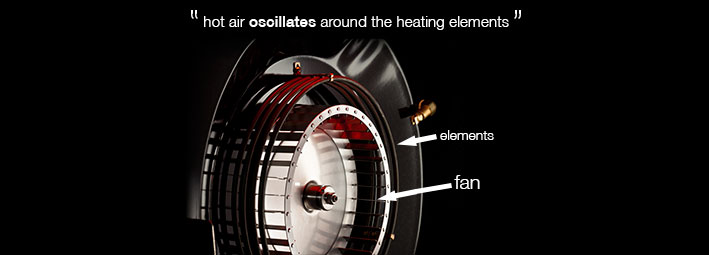
The Power
In selecting the right convection oven for your kitchen you need to understand your capacity requirements and then kilowatt to tray relationships then come into play. Looking for an oven with the highest kilowatt/energy output is not always the answer given, instead look at it as a relationship between the kilowatt output divided by the oven chamber capacity. For instance the Turbofan E32D4 – 4 tray digital electric convection oven features a 6.5kW output and there are 4 trays in the oven, now the trick is to divide the kilowatt output to the number of trays. This will identify the performance by tray depending on the size of the food product.Turbofan’s newest edition in the convection series is the E33D5, a 5 tray digital electric convection oven returning an impressive 1.16 kW per oven tray, exerting enough grunt to perfectly cook almost any oven based menu application.
The E33 range of convection ovens again takes this one step further with carefully regulated moisture control, which is injected into the oven chamber throughout the cooking process to gratify even the most difficult of dishes so that they can be kept from drying out. The five-level moisture injection mode of the E33 delivers this capability time and time again, and with no drainage required installation is a breeze.
The high performance bi-directional reversing fan system has been improved for the new E33 models with the introduction of two fan speeds. And with 5.8kW of heating power that means quality cooking capability – faster and more efficient.
The two-speed fan in the E33 models also provides greater control. High speed brings the grunt for maximum heat penetration. For more delicate products, low speed supplies the grace. Bake, roast, cook or regenerate – it doesn't matter.
Product loss from shrinkage is limited and so is unnecessary stress – you can rely on succulent results.
Energy efficiency in the kitchen
It’s no secret that commercial kitchen are high energy users, consuming roughly 2.5 times more energy per square metre than any other commercial space, which is why it is more crucial than ever to select an oven that has a practical level of energy efficiency. Energy efficiency in a convection oven boils down to the features of the oven, like – heat retention, quicker heat transference, functionality that enables the user to accomplish overnight cooking at lower cooking temperatures and much more.The Turbofan series of convection ovens do just that with two speed bi-directional fan technology that allows the users to limit energy output for their more delicate foods and in turn saving money on energy. Furthermore the lining inside the oven chamber is made up of vitreous enamel which is an excellent heat conductor meaning less work needs to be done by the motor because the heat stays inside the oven for even longer. And finally, the quicker heat transference is achieved through ultra-efficient heat circulation with the bi-directional fan technology which transfers the hot air around the oven chamber quickly thereupon less energy output required and faster cooking times achieved.
Saving Space
Experience proves that in many applications (especially in cafes and convenience stores) the space inside the kitchen is often very limited and as the hospitality industry continues to become more and more competitive the need to allow more space for more covers is constantly growing.In its conception, the newest addition to the Turbofan family, the E33 series of convection ovens aimed to achieve the most practical footprint with the perfect capacity balance. Turbofan now offers a new standard in reduced oven footprints, a broader product series and increased loading capacity to suit virtually any application. The E33T5 and E33D5 models each sit on a compact 610mm wide footprint and deliver a substantial five 1/1 gastronorm (GN) tray capacity with 85mm tray spacing.
With this size and scope energy savings are maximized and food loss minimised. That’s all the space and none of the waste.
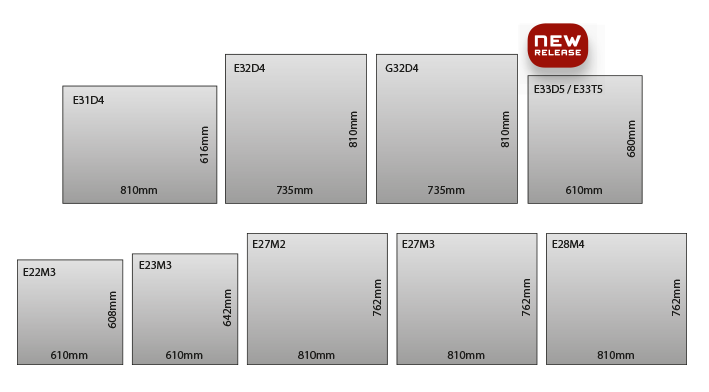
Turbofan offers industry-leading tray spacing for product loading versatility in all series ovens. The space within our oven cavities is fully functional for all applications. All Turbofan oven trays are built to GN tray capacity dimensions to match the universal standard of most commercial kitchen equipment, which can be very handy when you need to hold the trays at a secure HACCP certified temperature post cooking the product in the oven.






































